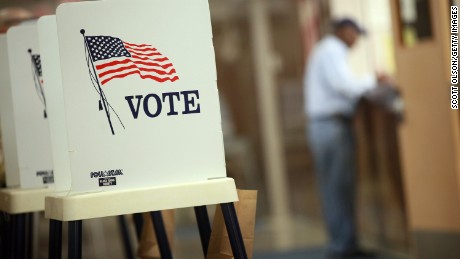
Hacking attacks. Voter intimidation. Foreign interference. No election in modern U.S. history has faced such a convergence of threats, some 21st century and others as old as democracy.
It’s testing the federal government’s ability to ensure the process is secure.
Even before an Oct. 21 cyber attack hampered access to popular websites, the Department of Homeland Security assigned more than 100 specialists around the country to help state and local election officials mitigate cybersecurity vulnerabilities. For the first time, the FBI will have an Election Day command post in Washington, and the Justice Department says it will watch for voter intimidation even after a court decision limited its ability to field observers.
“We are aware of the noise going on around the country, but we also have a history of doing this work in the context of elections that may be particularly fraught,” Vanita Gupta, head of the Justice Department’s Civil Rights Division, said in an interview. The division is in charge of protecting voters from discrimination based on race, religion, nationality and other protected categories.
All this comes as Republican presidential nominee Donald Trump has been trying to rally his base with claims that the election will be rigged. He has called on his supporters to go to the polls and watch voters, which some critics say could lead to intimidation and possible violence.
DHS, the Federal Bureau of Investigation and a little-known entity called the Multi-State Information Sharing and Analysis Center will serve as the focal point for the federal government’s triage on Election Day if there are hacking-related problems, with trained personnel ready to deploy to locations around the country, said a DHS official who asked not to be identified discussing the arrangements for Nov. 8.
That effort includes preparing for the election infrastructure to handle a major “DDoS” attack like the one last week that swamped a number of U.S. websites in a deluge of traffic. To date, 42 states and 29 county or local election agencies have sought cybersecurity assistance from DHS.
The biggest concern isn’t that hackers could manipulate the actual voting results — that’s almost impossible because most systems at polling places aren’t even connected to the Internet — but rather that they could sow confusion among voters through nefarious activities like altering information on websites listing the hours or locations of polling places, the official said.
The federal agencies and the nation’s biggest internet service providers will coordinate their efforts on Election Day through the National Cybersecurity and Communications Integration Center in the suburbs of northern Virginia.
Efforts to secure state and local election systems have been positive so far, according to the DHS official. The department isn’t anticipating widespread problems with voters showing up to the polls only to find that their information in registration databases has been manipulated, the official said.
There’s no evidence to date that vote-counting systems have been tampered with, and early voting in many states is already under way, the official said.
“We have confidence in the overall integrity of our electoral systems,” DHS said in a statement. “Nevertheless, we must face the reality that cyber intrusions and attacks in this country are increasingly sophisticated, from a range of increasingly capable actors that include nation-states, cyber hacktivists, and criminals.”
The Justice Department also plans to send hundreds of trained personnel to states to help deter voter intimidation. However, because of a 2013 Supreme Court ruling, the department will send fewer personnel than in 2012. The exact numbers and states won’t be released until just before the Nov. 8 election. Yet with more than 9,000 voting jurisdictions in the U.S., each with multiple polling locations, it’s impossible for the federal government to have eyes everywhere.
“It’s rigged. It’s a bad system,” Trump told supporters in Colorado Springs on Oct. 18, urging them to police urban voting. “Voter fraud is all too common. Take a look at Chicago, take a look at St. Louis. Take a look at some of these cities where you see things happening that are horrendous. And if you talk about them, they say bad things about you.”
According to election analysts and organizations such as FactCheck.org, a project of the Annenberg Public Policy Center in Pennsylvania, actual voter fraud is exceedingly rare in the U.S.
The Supreme Court’s 2013 decision in Shelby County v. Holder gutted a part of the 1965 Voting Rights Act that required states to get approval from the Justice Department before changing election laws. The ruling limited a process the department has used to justify sending certain specialized observers inside polling places. The department has interpreted the ruling to mean it doesn’t have authority to send as many observers as it did four years ago.
“We’re going to be spread a little thinner in each of the states that we’re going to be in, but we’re going to be in at least as many states as in 2012,” Gupta said.
In the world of U.S. election enforcement, observers differ from monitors because they are specially designated officials with the legal authority to enter polling places. Monitors don’t have the same authority. They generally watch for intimidation or voting irregularities from outside, such as lobbying by supporters of a party or candidate too close to the voting site. Monitors can be invited inside polling places by local officials.
Gupta said the department will remain vigilant, just as it has in prior years.
“Our monitors are going to be on the ground with as close a vantage point as possible,” Gupta said. “We will be doing everything we can to keep a close eye on the proceedings and to ensure that people are able to vote without obstruction.”
(c) 2016, Bloomberg · Chris Strohm

